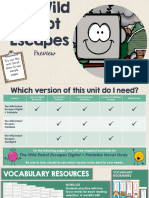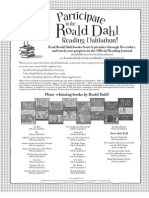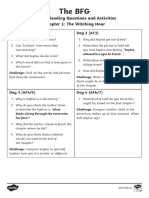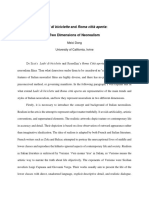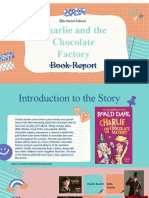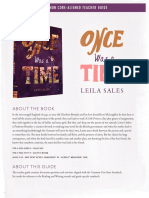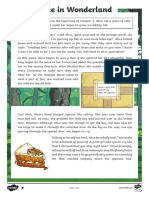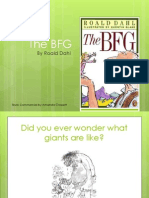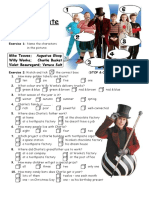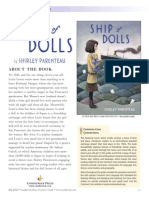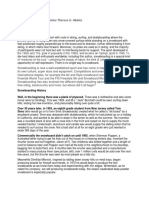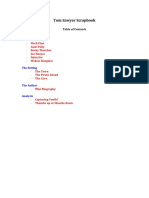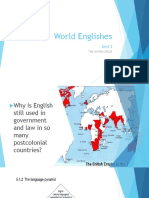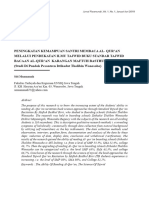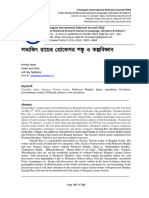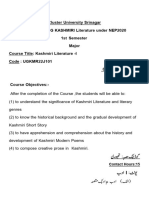The Children'S Theatre Company
The Children'S Theatre Company
Uploaded by
spartiatissa25Copyright:
Available Formats
The Children'S Theatre Company
The Children'S Theatre Company
Uploaded by
spartiatissa25Original Title
Copyright
Available Formats
Share this document
Did you find this document useful?
Is this content inappropriate?
Copyright:
Available Formats
The Children'S Theatre Company
The Children'S Theatre Company
Uploaded by
spartiatissa25Copyright:
Available Formats
www.childrenstheatre.
org
STUDENT/TEACHER STUDY GUIDE
is committed to creating extraordinary theatre experiences that educate, challenge, and inspire young people. It is our hope that by presenting significant themes that affect the lives of young people in our community we c a n h e l p t o f o s t e r d i a l o g u e a n d a c t i v e pa r t i c i pa t i o n i n t h e a r e n a s t h a t a f f e c t t h e i r l i v e s . I t i s w i t h t h i s i n m i n d t h a t w e o f f e r. . .
T H E C H I L D R E N S T H E AT R E C O M PA N Y
T I X : 6 1 2 - 8 74 - 0 4 0 0 0 6 - 0 7 S E A S O N
Mpls, MN 55404
The BFG is sponsored by
2006-2007 Season proudly sponsored by Target.
An experience in theatre can be a gateway into a greater understanding of who we are; it can enhance our understanding of life. You may come to The BFG(Big Friendly Giant) thinking that it is fun to break routine and go on a field trip to, and after having seen it, walk away with a feeling of having glimpsed a significant truth about the world and how each of us lives in it. So, while it is crucial to take the time to process the experience by talking and exploring the exciting theatrical experience itself, the time spent in the theatre can also serve as a springboard into many areas of your curriculum.
24 0 0 3 r d A v e . S .
The Big Idea...
Sophie and the Big Friendly Giant have the kind of friendship we want every child to have - one that surpasses any surface similarities or differences and is based on a deep connection and loyalty between two people. Their friendship surprises them, challenges them, and expands them. It makes them happier and braver than theyve ever been before. Embedded in this classically Roald Dahl world that imagines a reality ever so delightfully similar to and different from our own, Sophie and the BFG model the kind of friendship that can change the world.
T H E C H I L D R E N S T H E AT R E C O M P A N Y
www.childrenstheatre.org
Soon you and your class...
will see The BFG (Big Friendly Giant) at The Childrens Theatre Company, and we want your experience in the theatre to support your curriculum and classroom life. This Study Guide is designed to cover a broad range of needs, so please choose what is most useful in your own classroom. NOTE: the vertical section identifiers along the left edge of each page which help you navigate the Guide.
TABLE OF CONTENTS
T I X : 6 1 2 - 8 74 - 0 4 0 0 0 6 - 0 7 S E A S O N
TABLE OF CONTENTS
Background on BFG:
Before the show this information will prepare you for The BFG (Big Friendly Giant): The Story of The BFG: a synopsis of the play ............................................................ 2 Roald Dahl, the Author: ................................................................................................ 3 Related Resources: to use in preparation or in response to the play .......................... 4
Mpls, MN 55404
The BFG In the Classroom; Proportions/Language Arts:
A Question of Scale ..................................................................................................... 5 Language; Engaging the Imagination: writing, activity and discussion prompts........... 6 THE BIG IDEA: Friendship, Stereotypes; Changing the World: games, writing and discussion.... 7a/b Dream Catching: an activity on three levels ................................................................. 8
24 0 0 3 r d A v e . S .
Your Feedback:
...................................................................................................... 9
T H E C H I L D R E N S T H E AT R E C O M P A N Y
Minnesota Academic Standards Addressed:
Arts: The student will understand and use artistic processes to create, perform, and interpret art works in theater. Language Arts: Writing, Speaking, Listening and Viewing: The student will compose various pieces of writing and the student will communicate effectively through listening and speaking. Mathematics: The student will recognize ratios and comparative proportions as applied in particular situations.
QUESTIONS ABOUT PROCEDURE OR EXACT RUNNING TIME? CALL THE CTC BOX OFFICE AT 612-874-0400.
BFG Contents
www.childrenstheatre.org
THE STORY OF The BFG (Big Friendly Giant
A synopsis of the play adapted by David Wood From the book by Roald Dahl
BACKGROUND
T I X : 6 1 2 - 8 74 - 0 4 0 0 0 6 - 0 7 S E A S O N
Mpls, MN 55404 24 0 0 3 r d A v e . S .
One night Sophie is awakened by a moonbeam. She knows she needs to stay in bed or Mrs. Clonkers, who runs the orphanage, will be angry, but she wants to see what the world looks like at midnight. She creeps to the window and seesa giant! He plucks her out of her window and takes her away to his cave in Giant Country. He cant have her scuddling around yodelling the news that shes seen a giant. (He has a wonderful and unique way of talking). Since Sophie has seen him, the Big Friendly Giant cant let her go back to the orphanage. The good news is he wont eat her, like any other giant would do. This human gobbling that the other giants are doing is terrible! They kidnap and eat children all over the world. Neither Sophie nor the BFG like it to say the least. They do like each other, though. They have a lot in common. They both think snozzcumbers, the BFGs main food, taste awful! Frobscottle, though, is a delicious drink! (Even though it causes whizpoppers farts something humans think are rude, but giants enjoy immensely). The BFG is a dream-blowing giant. He collects dreams in jars, and blows them into the bedrooms of sleeping children. Some dreams are lovely, but others are nightmares! One night, while dreamcatching, Sophie and the BFG overhear the giants, Meatdripper, Fleshlumpeater, and Bloodbottler planning to go to England to eat children. The friends must tell the Queen! They go to Buckingham Palace and end up having breakfast with a very surprised Queen. The English Queen gets reports that children have indeed been eaten and confers with the Queen of Sweden who confirms that her countrys children have been disappearing, too, eaten by giants. This calls for war! The BFG helps the Army and Air Force hatch a plan to go to Giant Land and capture the child-eating monsters. Helicopters fly over Meatdripper, Fleshlumpeater, and Bloodbottler as they sleep, soldiers tie them in ropes, and fly them to London Zoo where they are dropped in a colossal hole in the Zoo. The BFG is awarded the Queens Medal for Gigantic Courage on behalf of England and the whole world; Sophie is invited to live at Buckingham Palace. And even though the BFG walks off into the sunset, we know that, as long as Sophie lives in the palace, he will be back.
Sophie is an orphan, which can be lonely. The Big Friendly Giant likes human beings, which for a giant can be lonely, too. (Most giants dont like people except for supper.) Its no surprise Sophie and the BFG become best friends. He talks all squiffsquiddly, and she understands per fectly. But wait , hes a giant! Shes a little girl! Their fantastic friendship is pure Roald Dahl. Wickedly funny; surprising... and puppets, too!
T H E C H I L D R E N S T H E AT R E C O M P A N Y
BFG PAGE 1
www.childrenstheatre.org
ROALD DAHL , the author,
was born in South Wales in 1916. His parents were Norwegian, and he was particularly fond of his mother. He was educated in English boarding schools, which he didnt like much. When he finished school he went to Africa with an oil company, and then when World War II broke out he joined the RAF as a fighter pilot. His plane was shot down in 1942 and he returned home. He was interviewed for an American magazine because of his injury, and wrote a story about his experience in the war, which was published without one word being changed! He earned $900 for that first story and realized he was a writer. Most of his first work was factual articles for magazines. Then her wrote short stories for adults as he began to enjoy using his imagination and writing fiction. When he had growing children of his own asking him to tell bedtime stories he began to write what he became a glorious master at writing: childrens stories. His first book for children was The Gremlins, soon followed by James and the Giant Peach in 1960 (he first thought to make it a giant cherry!) and Charlie and the Chocolate Factory (Roald Dahl loved chocolate and kept a large and surprisingly heavy ball of silver paper made from chocolate wrappers on the table beside him when he wrote). He also wrote Matilda, The Twits, The Witches, Boy, The BFG and many others (21 childrens books in all). Every day when Roald Dahl went to work writing he went out through the orchard in back of his house in Buckinghamshire to a tiny white hut with a bright yellow door. He never let anyone else come in. He sat in a big chair, put a pillow on his lap, his very long legs up on a footstool, covered himself with a blanket and propped a tablet on top of it all. He wrote by hand with a table full of interesting objects nearby and photos of wondrous places and people all around. From this one place he created many worlds. His favorite color was yellow, and he loved spiders and oxtail soup (but not together)! He wrote a collection of 283 new words that he made up while writing The BFG, which he called Gobblefunk. Roald Dahl died of a blood disease on November 23, 1990. This year is the first ever Roald Dahl Day in England. It would have been his 90th birthday, September 19, 2006. A wonderful site for all things Dahl: http://www.roalddahl.com/ Roald Dahl Day: http://www.randomhouse.co.uk/childrens/roalddahl/day/home.html The photo above is from: www.uitgeverijdefontein.nl/auteurs/biografieen/dahl.html
BACKGROUND
T H E C H I L D R E N S T H E AT R E C O M P A N Y
24 0 0 3 r d A v e . S .
Mpls, MN 55404
T I X : 6 1 2 - 8 74 - 0 4 0 0 0 6 - 0 7 S E A S O N
Many of Roald Dahls books could be considered satires. Satire is writing which puts the mean or harmful or ridiculous habits of human beings right out in the open where we can see them for the mean, harmful, ridiculous things they are. Usually satire accomplishes this goal by making us laugh at the same time, and it gives us a chance to want to change things - and ourselves - for the better. QUESTION: Is BFG satire? How?
BFG PAGE 3
www.childrenstheatre.org
RELATED RESOURCES:
THE BFG (BIG FRIENDLY GIANT) is based on a book by Roald Dahl. Any library will have a selection of his books. A partial listing: James and the Giant Peach, Charlie and the Chocolate Factory, Matilda, Witches, and The BFG. It is worth noting that the first four titles have all been made into movies that are easily available for rental. Both James and the Giant Peach and Matilda capture the exquisitely real/surreal flavor of Roald Dahl's writing particularly well. The Boy Who Loved Words, by Roni Schotter. After helping a poet find the perfect words for his poem (lozenge, lemon, and licorice), a boy learns his purpose is to spread the word to people in need. (ages 5 to 10) Drita, My Homegirl, by Jenny Lombard. Ten year old Drita and her family move to New York from Kosovo and forms an unexpected friendship with a popular girl, Maxine. (ages 10 to 12) Frindle, by Andrew Clements. A clever boy invents a new word in response to his 5th grade teacher who loves words, and begins a chain of events that moves beyond his control. (ages 8 to12) Inkdrinker, by Eric Sanvoisin. A boy who hates books discovers an inkdrinking vampire in his father's bookshop and follows him to his underground vault. (ages 8 to 12) My Friend the Enemy, by J. B. Cheaney. During World War II, a girl becomes friends with a Japanese-American boy she discovers being hidden by her neighbor. (ages 8 to 12) The Phantom Tollbooth, by Norman Juster. Milos boredom disappears when he journeys through a land where he learns the importance of words and numbers. (ages 8 to 12)
BACKGROUND
Mpls, MN 55404
T I X : 6 1 2 - 8 74 - 0 4 0 0 0 6 - 0 7 S E A S O N
T H E C H I L D R E N S T H E AT R E C O M P A N Y
BFG PAGE 4
Use this to make a bookmark, bookplate, or ID tag for when your group visits the theatre. Copy it on to cardstock or sticker paper, cut out, and decorate.
24 0 0 3 r d A v e . S .
www.childrenstheatre.org
A QUESTION OF SCALE
One of the interesting questions that needed to be addressed in order to put giants from Giant Country and humans from Sophies world (England) together on stage was how to create a realistic difference in size. One way this is done is with puppets. You might see a very small Sophie puppet talking to a human sized giant, or a very large giant talking to a human sized Sophie, or even both at the same time!! In this production of THE BFG (Big Friendly Giant) everything is created at a ratio of 1 to 4. That means things in Giant Country are four times bigger than things in Sophies world. Or you might say that things in Sophies world are four times smaller than things in Giant Country. An example: The BFGs ruler would be four feet long in Sophies hand; Sophies ruler would be three inches long in the BFGs hand. Draw your own example (the silhouette helps you visualize the scale).
IN THE CLASSROOM
T I X : 6 1 2 - 8 74 - 0 4 0 0 0 6 - 0 7 S E A S O N
Mpls, MN 55404
These two rasdoodles may look like they are the same size, but theyre not! The rasdoodle in the top box is from Giant Country. That means it is four times bigger than a rasdoodle in Sophies world. Draw a person or part of a person beside it in scale. The rasdoodle below is from Sophies world, so to a giant it is four times smaller than you would expect a rasdoodle to be. Draw part of a giants hand in scale beside it. NOTE: To accurately determine the scale consider the rasdoodle berry (minus leaves and tail) to be exactly 1 unit of measure long.
T H E C H I L D R E N S T H E AT R E C O M P A N Y
24 0 0 3 r d A v e . S .
BFG PAGE 5
www.childrenstheatre.org
L ANGUAGE: CONTEXT & IMAGINATION
The BFG talks squiff-squidly. And yet we understand what he says! How do we understand words weve never heard before? And how much context is required for understanding new words?
This poem is famous for being full of made up words that somehow make sense!! See if you understand it when you read it out loud. You and your friends may not think every word means exactly the same thing, but you can agree on the story being told. Discuss how you can understand what a new word means because of the words and ideas around it. Jabberwocky, by Lewis Carroll (1872) ..."Beware the Jabberwock, my son! The jaws that bite, the claws that catch! Beware the Jubjub bird, and shun The frumious Bandersnatch!" He took his vorpal sword in hand: Long time the manxome foe he sought -So rested he by the Tumtum tree, And stood awhile in thought. And, as in uffish thought he stood, The Jabberwock, with eyes of flame, Came whiffling through the tulgey wood, And burbled as it came!...
(Find it at: http://www.jabberwocky.com/carroll/jabber/jabberwocky.html) An illustration by Quentin Blake
IN THE CLASSROOM
Mpls, MN 55404
T I X : 6 1 2 - 8 74 - 0 4 0 0 0 6 - 0 7 S E A S O N
T H E C H I L D R E N S T H E AT R E C O M P A N Y
In contrast to Jabberwocky, this poem is famous for being difficult to understand. Yet it has no imaginary words in it at all it is simply written in Middle English, an old language spoken more than 500 years ago. See if you can understand its meaning when it is read aloud. What is it that makes it more difficult to understand? The key is how much understandable context there is in proportion to the unusual words.
Canterbury Tales, by Geoffrey Chaucer (1400) Whan that aprill with his shoures soote The droghte of march hath perced to the roote, And bathed every veyne in swich licour Of which vertu engendred is the flour... Thanne longen folk to goon on pilgrimages... And specially from every shires ende Of engelond to caunterbury they wende, The hooly blisful martir for to seke, That hem hath holpen whan that they were seeke.
24 0 0 3 r d A v e . S .
The BFG:
You will be coming to an ucky-mucky end if Bloodbottler should ever be getting his gogglers upon you. You would be swallowed up like a piece of frumpkin pie, all in one dollop.
A Collection: As you are watching the play, notice the unusual words the
giant uses. When you get back to your classroom make a list on the board of all the words your class can remember. Define the words together and talk about how you knew their meaning by using contextual clues from the play.
BFG PAGE 6
www.childrenstheatre.org
Friendship
The BFG is not what Sophie expects a giant to be, and he is definitely not what she expects a friend to be! What is it that turns someone who is completely and extraordinarily different than yourself into your best friend? Its impossible to know for surebut it happensin Giant Country, and our world, too. Sometimes when theres nothing on the outside of two people that looks matchable there is something inside that matches in a way only they can see. Then they recognize each other as exactly compatible and become friends; extraordinary friends. And if you are lucky enough like Sophie and the BFG - to know that kind of friendship, you know that it gives you courage and joy and someday just may make you a hero.
IN THE CLASSROOM
T I X : 6 1 2 - 8 74 - 0 4 0 0 0 6 - 0 7 S E A S O N
Mpls, MN 55404
UNLIKELY FRIENDS STEREOTYPES FEAR OF DIFFERENCE HEROES FAMOUS FRIENDS UNLIKELY FRIENDS: Why is friendship important in the world? What would it be like if no one had a friend?
Sometimes people just dont expect two people to have anything in common, and then they find out they are friends! Youve probably thought that looking at two other people...thought, Why on earth are they friends? Sophie and the BFG are like that. Nobody would expect a giant and a little girl to be friends! But they are. Do you have this kind of friend? If you dont can you make one up? Draw a picture of that friend whether real or imagined. MORE ADVANCED: Write a detailed description of an unusual friend, real or imagined. THE NEXT LEVEL: Write a short story or dramatic scene which hinges on an unusual friendship which must withstand some kind of pressure.
STEREOTYPES How do stereotypes affect the choices we make in our lives? How do we overcome them?
One way to think of stereotypes is as a set of expectations. Have you ever heard someone say, I didnt expect you to like sports, or I expected you to look more like your sister? We all walk around collecting information about what we think might be around the next corner. Thats the way we learn. The problem is that sometimes what is around the next corner is very different from what weve learned in the past. The BFG is nothing like the giants Sophie has read about or heard about in stories. Make a list together of the kinds of things we use to create stereotypes or expectations: Examples: gender, age or grade level, ethnicity, hair style. Now have a discussion about whether or not these expectations are accurate. MORE ADVANCED: Play this game and experience turning expectations upside down. What Are You Doing? Students line up in two lines that both feed into the center of the play space. One student begins by walking to the center. He or she silently pantomimes a recognizable activity. Example: brushing teeth. A second student walks in from the other line and copies the first, doing exactly the same thing. She or he then asks, What are you doing? The first student must then answer with an activity that is anything EXCEPT the expected answer. Example: walking my dog. Then the first student leaves and rejoins a line. The second student immediately begins to pantomime the activity that was named and when that is established another enters. The pattern repeats endlessly. Afterwards...talk about it.
T H E C H I L D R E N S T H E AT R E C O M P A N Y
24 0 0 3 r d A v e . S .
BFG PAGE 7a
IN THE CLASSROOM
Mpls, MN 55404 24 0 0 3 r d A v e . S .
FEAR OF DIFFERENCE Have you ever been afraid of someone who acts, speaks, looks, or thinks differently than you? Why do you think you were frightened? Can difference ever be positive? Most of us are drawn to people and circumstances that are familiar to us; while that may be a safe choice, it may not be the best choice to be fully engaged in the world. Some fear of difference comes as a by-product of our desire to find a sense of commonality with others. This activity is a chance to explore that idea. It can be done together as a class, individually, or in small groups. It can be done using drawings or verbal descriptions. 1) Imagine a set of several students you might find in a classroom. Make sure the description or drawing includes at least three characteristics. Example: A freckle faced Caucasian girl in a chess club t-shirt who uses a wheelchair. A tall African American boy wearing glasses who is carrying Harry Potter and the Half Blood Prince. 2) Now, imagine that you are a new student on the first day of school, and must ask someone to help you find your classroom. Choose who you would be MOST and LEAST likely to ask for help and why. Write it down or take turns. Usually, it is because something visible makes it seem there is a similarity shared, or that there is nothing in common. Example: You like chess; you are African American, OR you dont know anybody who uses a wheelchair; you detest Harry Potter. 3) Finally discuss as a group how imagining some options felt easy and comfortable and others felt awkward or even frightening. Talk together about what that might mean to a person, especially in situations where s/he might feel no one is similar at all, and also how its possible to learn new things when contact with a person who is similar in some ways also acquaints you with differences. Example: I chose the girl with freckles because I have them and I learned to play chess (which I thought was impossible). MORE ADVANCED: This activity quite naturally expands and becomes a deeper experience with older students and more mature students. It could serve as a springboard into poetry or essay writing. HEROISM What does it mean to be brave? How do ordinary people find ways to do heroic deeds? Discuss this statement: We become courageous when what needs to be done is more important than our fears. Think of examples and write them on the board. You can start very basic. Example: going to the dentist. Discuss what it is that is frightening about each example and why the things mentioned are important to do. Ask questions such as: If Sophie and the BFG were both afraid of the dentist would it help to go together? Finally, talk about what kind of misbehavior might result from fear when there is no perceived importance or friend to help us do the right thing. Then write (together or separately) a new ending to the play in which all the giants, Bloodbottler, Fleshlumpeater, and the rest find a way to do something heroic and wonderful because they find good friends like Sophie to help them be brave enough to do what is right. In this new version they will not have to be captured and kept in a zoo!! MORE ADVANCED: Each progressive bullet point carries this activity deeper. In this way it expands and becomes a deeper experience with older students and more mature students. FAMOUS FRIENDS Research and report on famous friendships in literature. Examples: Frog and Toad; Harry Potter, Ron and Hermione; Sherlock Holmes and Doctor Watson; Nancy Drew, George and Bess. Or think of some from real life!
T I X : 6 1 2 - 8 74 - 0 4 0 0 0 6 - 0 7 S E A S O N
www.childrenstheatre.org
T H E C H I L D R E N S T H E AT R E C O M P A N Y
BFG PAGE 7b
Illustration by Meri C Fox-Szauter
www.childrenstheatre.org
Dream Catching
We all dream. Adventures float and whiz and pop and jiggle through our minds while we sleep. Then we wake up and they try to escape! We must catch them quickly in the very twinkling moment we awake if we want to keep them. The Big Friendly Giant knows how to catch dreams. He catches dreams like butterflies and blows them through the windows of sleeping children. Of course sometimes he just like we catches something else entirelya trogglehumper, a bad dream.
IN THE CLASSROOM
T I X : 6 1 2 - 8 74 - 0 4 0 0 0 6 - 0 7 S E A S O N
Find the matching dreams in the BFGs Dream Jar. There is only one that is unique - it has no match. That one is yours. See if you can find it.
If youve ever caught a nasty trogglehumper that you need to put away, write (or draw) what it was about. This jar has a tight, tight lid and wont ever let it get away.
Write a luscious dream one you had or one you imagine. It might be a lovely phizzwizard or a funny whoopsy dream. The important thing is that its yours.
Mpls, MN 55404
_____________________ _____________________ _____________________ _____________________ _____________________ _____________________ _____________________ _____________________ _____________________
24 0 0 3 r d A v e . S .
__________________________________________ __________________________________________ __________________________________________ __________________________________________ __________________________________________
T H E C H I L D R E N S T H E AT R E C O M P A N Y
NOTE TO TEACHER: this activity can function on many levels. Young students can match the dream words and have a conversation about the important role dreams play in the play. Older students may write or draw remembered or imagined dreams. More mature students may use this page as a writing prompt to explore the importance of dreams, create a short story or scene based on a dream, or do a plot analysis of the BFG including the important turning point which occurs because of a dream.
BFG PAGE 8
ANSWER to Dream jar puzzle: the all capitol letters word in the lower right corner of the jar has no match.
www.childrenstheatre.org
your response is valuable as we seek to redesign our study materials. Thank you.
I. Did using this Study Guide add to your theater experience? Yes Some No 2. How much of the Study Guide did you read? Didnt have time About a quarter
FEEDBACK
All
T I X : 6 1 2 - 8 74 - 0 4 0 0 0 6 - 0 7 S E A S O N
Mpls, MN 55404
YOUR FEEDBACK
3. What do you think of what you read? Mark as many as apply. Useful Enjoyable Nothing new Not for my students because 4. Did you get the Study Guide in time to prepare to see the play? Yes No Comment _____________________________________________________________________________ 5. What sections of the Study Guide did you find most important? _____________________________________________________________________________ 6. How did the experience of preparing for and then seeing the play impact you students? _____________________________________________________________________________ 7. Did you spend more time working with the material BEFORE or AFTER the play? Before After About the Same 8. Which of the following best describes you? middle school high school I teach: home school other_____________________________________________________ Comments: ____________________________________________________________________
(continue on separate page if desired)
24 0 0 3 r d A v e . S .
T H E C H I L D R E N S T H E AT R E C O M P A N Y
M A I L T O : THE CHILDRENS THEATRE COMPANY/2400 3RD AVE. SO. MINNEAPOLIS, MN 55404-3597/A T T N : E DUCATION D EPT.
The Children's Theatre Company, awarded the 2003 Regional Tony Award for sustained artistic excellence, is nationally and internationally acclaimed as America's flagship theatre for young people and families. Each year, The Children's Theatre Company's public performances, school matinees, regional tour performances, and Theatre Arts Training Programs serve nearly 330,000 people. Peter Brosius, Artistic Director Teresa Eyring, Managing Director Gregory Smith, Director of Education Study Guide written by Chris Kliesen Wehrman, August 06. Thanks to Gregory Smith, Stacy Hawkins, and Katie Leo.
BFG PAGE 9
You might also like
- Preview: SampleDocument27 pagesPreview: Samplerafly.anugNo ratings yet
- WishDocument15 pagesWishVishnupriya VenugopalNo ratings yet
- Nikki and Deja: Substitute TroubleDocument10 pagesNikki and Deja: Substitute TroubleHoughton Mifflin HarcourtNo ratings yet
- Touch of Sexual AssaultDocument4 pagesTouch of Sexual Assaultatlas.music.mapNo ratings yet
- James and The Giant Peach Study Guide Grades 4th-8thDocument19 pagesJames and The Giant Peach Study Guide Grades 4th-8thSana AnsarNo ratings yet
- Fantastic MR Fox Question Booklet v2Document10 pagesFantastic MR Fox Question Booklet v2Lingoes Wy KimNo ratings yet
- BFG Novel UnitDocument38 pagesBFG Novel UnitThomso46No ratings yet
- Using The BFG in The ClassroomDocument12 pagesUsing The BFG in The ClassroomNancy100% (5)
- Plp-Part BDocument10 pagesPlp-Part Bapi-654229033No ratings yet
- Activities 10Document8 pagesActivities 10Katie GodziszewskiNo ratings yet
- Roald Dahl CharlieDocument4 pagesRoald Dahl Charliemarsorianobeb100% (1)
- The BFG: Guided Reading Questions and Activities Chapter 1: The Witching HourDocument23 pagesThe BFG: Guided Reading Questions and Activities Chapter 1: The Witching HourMs Chapman100% (2)
- Story AnalysisDocument17 pagesStory Analysissalsabila nadzifaNo ratings yet
- The Little Snowplow Wishes For Snow Activity KitDocument9 pagesThe Little Snowplow Wishes For Snow Activity KitCandlewick PressNo ratings yet
- Ladri Di Biciclette and Roma Città Aperta:: Two Dimensions of NeorealismDocument5 pagesLadri Di Biciclette and Roma Città Aperta:: Two Dimensions of Neorealismapi-563527004No ratings yet
- BFG - VocblryDocument11 pagesBFG - Vocblrymasoud andishmandNo ratings yet
- Hatchet Chapters 1-4 GuideDocument3 pagesHatchet Chapters 1-4 GuideJulian Mauricio ZuluagaNo ratings yet
- Witches SOWDocument28 pagesWitches SOWconchymd100% (9)
- Reading Log Kristin MontgomeryDocument23 pagesReading Log Kristin Montgomeryapi-493537577No ratings yet
- Rif Read Aloud Tips GuideDocument18 pagesRif Read Aloud Tips Guideapi-538953209No ratings yet
- Book Report 1Document11 pagesBook Report 1api-607065237No ratings yet
- BFG ActivityDocument12 pagesBFG ActivitySaba KhanNo ratings yet
- Book Trailer Storyboard For The One and Only IvanDocument7 pagesBook Trailer Storyboard For The One and Only IvanCourtney CookNo ratings yet
- THE LONDON EYE MYSTERY ACTIVITIES CH 25 - 41Document3 pagesTHE LONDON EYE MYSTERY ACTIVITIES CH 25 - 41ddenoaldanaNo ratings yet
- Once Was A Time Teacher GuideDocument4 pagesOnce Was A Time Teacher GuideChronicleBooksNo ratings yet
- Goldilocks and The Three Bears Story For KidsDocument2 pagesGoldilocks and The Three Bears Story For KidsElena ReinaNo ratings yet
- t2 e 41967 Uks2 Alice in Wonderland Differentiated Reading Comprehension Activity English Ver 6Document18 pagest2 e 41967 Uks2 Alice in Wonderland Differentiated Reading Comprehension Activity English Ver 6Diana AdamNo ratings yet
- The South China Sea in The Age of European DeclineDocument58 pagesThe South China Sea in The Age of European Declinedemop100% (4)
- Y6 WK5 LP4 Charlie and The Great Glass ElevatorDocument9 pagesY6 WK5 LP4 Charlie and The Great Glass Elevatorاحمد ابراهيمNo ratings yet
- Anne Frank Study GuideDocument5 pagesAnne Frank Study GuideapperdapperNo ratings yet
- The BFG Book CommercialDocument15 pagesThe BFG Book Commercialapi-254140549100% (2)
- The Giraffe and The Pelly and MeDocument5 pagesThe Giraffe and The Pelly and MeThe GisseStyleNo ratings yet
- Gangsta-Granny Book-Aid-InternationalDocument3 pagesGangsta-Granny Book-Aid-Internationalapi-237637287No ratings yet
- Frindlebookclubpacket 1Document43 pagesFrindlebookclubpacket 1api-266088722100% (1)
- A Girl A Raccoon Midnight Moon Teacher GuideDocument8 pagesA Girl A Raccoon Midnight Moon Teacher GuideChronicleBooksNo ratings yet
- 08 Henry and Mudge and The Happy CatDocument6 pages08 Henry and Mudge and The Happy CatBahman YagubovNo ratings yet
- Round HE Orld N 0 AYS: A T W I 8 DDocument4 pagesRound HE Orld N 0 AYS: A T W I 8 DJohnny AbadNo ratings yet
- Dear MR Henshaw LPSampleDocument36 pagesDear MR Henshaw LPSampleElizabeth Vanessa Santisteban MuñozNo ratings yet
- A Wrinkle in Time TeaDocument7 pagesA Wrinkle in Time TeaTea Danguilan0% (1)
- The Lion The Witch and The WardrobeDocument9 pagesThe Lion The Witch and The Wardrobeapi-220720690No ratings yet
- Beverly, Right Here by Kate DiCamillo Discussion GuideDocument3 pagesBeverly, Right Here by Kate DiCamillo Discussion GuideCandlewick PressNo ratings yet
- Charlie and The Chocolate Fabric Movie ActivityDocument2 pagesCharlie and The Chocolate Fabric Movie ActivityNIARA PRADONo ratings yet
- OLIVER TWIST STUDY GUIDE Final PDFDocument22 pagesOLIVER TWIST STUDY GUIDE Final PDFAntonietta Solimando100% (1)
- The One and Only Ivan PromotionDocument10 pagesThe One and Only Ivan Promotionapi-218134068No ratings yet
- Ivy + Bean Activity KitDocument15 pagesIvy + Bean Activity KitChronicleBooksNo ratings yet
- Roald DahlDocument13 pagesRoald DahlAyesha KhatibNo ratings yet
- Phizz-Whizzing: Marvellous Themes Of: Explore TheDocument55 pagesPhizz-Whizzing: Marvellous Themes Of: Explore TheSandip RayNo ratings yet
- Notes For Five Children and ItDocument5 pagesNotes For Five Children and ItArchana ShyamsunderNo ratings yet
- Skrap Book Around The World in 80 DaysDocument28 pagesSkrap Book Around The World in 80 Dayslanita7471No ratings yet
- Billionaire Boy Worksheet (JGA)Document7 pagesBillionaire Boy Worksheet (JGA)Jeshua GUSHIKEN AKAMINENo ratings yet
- Rise of ZomBert Author's NoteDocument2 pagesRise of ZomBert Author's NoteCandlewick PressNo ratings yet
- Ship of Dolls Teachers' GuideDocument5 pagesShip of Dolls Teachers' GuideCandlewick PressNo ratings yet
- My Teacher Wasn't Half As Nice As Yours Seems To Be by Roald DahlDocument7 pagesMy Teacher Wasn't Half As Nice As Yours Seems To Be by Roald DahlSyafqhNo ratings yet
- The Wild Robot Escapes Comprehension Chapters 21-25Document2 pagesThe Wild Robot Escapes Comprehension Chapters 21-25thebraincrampNo ratings yet
- Reading Comprehension: Reading Skills Practice Test 4Document5 pagesReading Comprehension: Reading Skills Practice Test 4Soka WTNo ratings yet
- Stig BookDocument11 pagesStig BookDawudBryantNo ratings yet
- The Suitcase Kid-Jacqueline WDocument5 pagesThe Suitcase Kid-Jacqueline WaisyahNo ratings yet
- A Christmas CarolDocument14 pagesA Christmas CarolDaniela KostadinovaNo ratings yet
- SNOWBOARDING - Jasmine Therese G. AbalosDocument30 pagesSNOWBOARDING - Jasmine Therese G. Abalosjasmine AbalosNo ratings yet
- Literature Circle QuestionsDocument3 pagesLiterature Circle QuestionsLesia EnglishNo ratings yet
- 2023 Biologi Analisis Item - 2023 Biologi Peperiksaan 1 (Responses)Document50 pages2023 Biologi Analisis Item - 2023 Biologi Peperiksaan 1 (Responses)Adriel GohjjNo ratings yet
- POETRY CreWriDocument59 pagesPOETRY CreWriChristine Jade MonteraNo ratings yet
- CM 2 - MA + Verse Form (I) 2021Document14 pagesCM 2 - MA + Verse Form (I) 2021Freddysfraid FreddysfraidNo ratings yet
- Tips - The Execution of Mayor Yin and Other Stories FromDocument237 pagesTips - The Execution of Mayor Yin and Other Stories Fromzina khafajiNo ratings yet
- The Story of Keesh Critique PaperDocument2 pagesThe Story of Keesh Critique PaperErica Pau's Life0% (1)
- Who Is WhoDocument2 pagesWho Is WhoJana lolNo ratings yet
- Fraud, Famine and Fascism - Douglas TottleDocument176 pagesFraud, Famine and Fascism - Douglas TottleGianluca Giachè100% (2)
- Lexi C OgraphyDocument13 pagesLexi C OgraphyLovelyn Maristela100% (1)
- WEEK 8 JOHN DRYDEN 18032024 112016pm 13102024 124615amDocument13 pagesWEEK 8 JOHN DRYDEN 18032024 112016pm 13102024 124615amShahzaman NaraiNo ratings yet
- Tom Sawyer ScrapbookDocument8 pagesTom Sawyer Scrapbookapi-429780185No ratings yet
- The Two FrogsDocument5 pagesThe Two FrogsZaki AziziNo ratings yet
- Home, Belonging, and The Politics of Belonging in Mohsin Hamid's The Reluctant FundamentalistDocument9 pagesHome, Belonging, and The Politics of Belonging in Mohsin Hamid's The Reluctant FundamentalistAveen SarkawtNo ratings yet
- Macbeth Act 1 SC 1& 2 NotesDocument2 pagesMacbeth Act 1 SC 1& 2 NotesAarav JoshiNo ratings yet
- Creative Nonfiction Grade 12 - Humss Second Semester Quarter 1 - Module 1Document9 pagesCreative Nonfiction Grade 12 - Humss Second Semester Quarter 1 - Module 1Reychel NecorNo ratings yet
- Week 10 11 Outer CircleDocument50 pagesWeek 10 11 Outer CircleZehra NuralpNo ratings yet
- Cinderella's RoutineDocument3 pagesCinderella's RoutineBetiana GrilloneNo ratings yet
- Namdeo Dhasal - Poems - : Classic Poetry SeriesDocument5 pagesNamdeo Dhasal - Poems - : Classic Poetry SeriesSachin TibeNo ratings yet
- 182-Article Text-212-1-10-20180726Document11 pages182-Article Text-212-1-10-20180726Faelasufa MaulidaNo ratings yet
- Humour, Vulgarity and Meaning in Tiv Proverbs by Sylvester OrndirDocument17 pagesHumour, Vulgarity and Meaning in Tiv Proverbs by Sylvester OrndirSylvester OrndirNo ratings yet
- Spivac Politics of Translation-NoteDocument2 pagesSpivac Politics of Translation-NoteMunavvira MinnuNo ratings yet
- A Lost Arabic Koran Rediscovered PDFDocument20 pagesA Lost Arabic Koran Rediscovered PDFvstrohmeNo ratings yet
- Div Week5 Q2Document8 pagesDiv Week5 Q2Roselle Macaraeg-FloresNo ratings yet
- Trisangam International Refereed Journal (TIRJ)Document6 pagesTrisangam International Refereed Journal (TIRJ)TRISANGAM INTERNATIONAL REFEREED JOURNAL (TIRJ) EDITOR - MR. PRASENJIT ROYNo ratings yet
- Class 12 English Core Flamingo NotesDocument4 pagesClass 12 English Core Flamingo NotesLalitha GorantlaNo ratings yet
- A Marxist Perspective 30122022 3Document5 pagesA Marxist Perspective 30122022 3ljr36009No ratings yet
- Transmutation of RhetoricDocument4 pagesTransmutation of RhetoricJl WinterNo ratings yet
- KashmiriLi KashmiriLiteratureIMajorDocument6 pagesKashmiriLi KashmiriLiteratureIMajordanishrazaqlone974No ratings yet
- BookmarkDocument9 pagesBookmarkZion LauNo ratings yet
